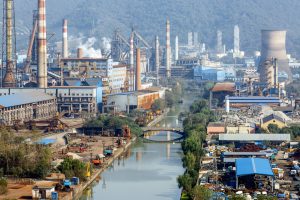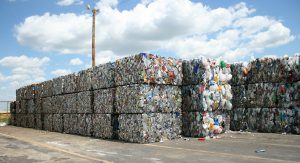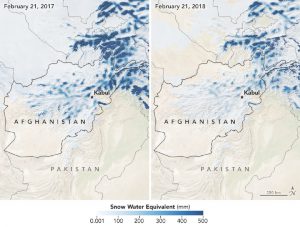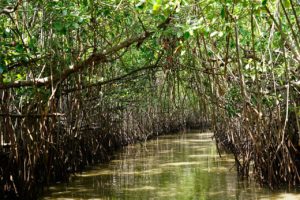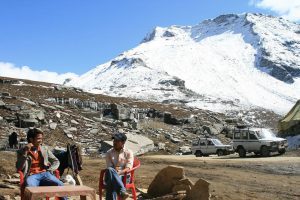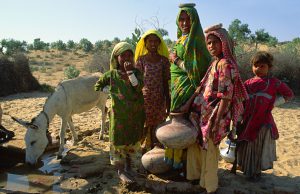Isabel Hilton (IH): Well I think that people don’t quite understand that China has become a major ocean power now, […] it’s also one of the major sources of marine pollution of all kinds, and plastic pollution in particular.
Marcy Trent Long (MTL): This is Eight Million – a podcast series that looks at the eight million metric tonnes of plastic entering our oceans every year – and the role China is playing to address this global challenge. Eight Million is produced by Sustainable Asia and its partners China Dialogue and Aya Recording Studio.
MTL: Plastic waste in the ocean has hit a tipping point – and we are all to blame for it. But what are the reasons so much plastic leaves our shores and heads into the ocean? And how is China – home to 1.3 billion people – handling their massive amount of waste so it doesn’t end up in waterways?
To start the discussion, let’s hear from Isabel Hilton. Isabel runs the bilingual website China Dialogue, dedicated to promoting a common understanding of China’s urgent environmental challenges.
IH: I think there has been a tremendous evolution of thinking in China. When we first started in 2006, the view was very much develop first, clean up later. The environment is something that rich countries can afford, poor countries can’t.
And then, I think as China’s industrial revolution itself came to the closing phases, people began to understand that the cost was very high indeed. And ideas of the circular economy, of sustainable development, began to move in from the edges right into the central policy space. And pretty much that’s where they are now.
I would very much hope that ecological civilisation, which is now, state policy, will eventually lead to less plastic pollution.
We have all had industrial revolutions before, done these terrible things to the environment – there are lessons nevertheless that can be learned – and we need to share them.
If we don’t approach a problem collectively, then we have very little chance of resolving any of these issues.
MTL: Over the course of five episodes, we’ll look at the problem of plastic in our oceans, and what we can do about it. During this period when America is pulling out of many global environmental commitments – can China take a leading role to help stop the flow of plastic into the ocean?
IH: China took a rather important step in restricting its imports of plastic waste, because it is important to understand that China produces a huge amount of plastic waste by volume but quite a lot of that has been imported plastic waste from elsewhere. So countries like Britain, the US, European Union, instead of dealing with their own plastic problem, have essentially been outsourcing their plastic to other countries, and China has been a major part of that.
The problem was a lot of the waste was shipped to China, was not actually recyclable, so it ends up in the ocean anyway. And it ends up on China’s ticket rather than on the EU or US ticket. If China is now not going to do that any longer, then that will force developed countries to take a more responsible position on their plastic.
MTL: But where to start? Should we be promoting recycling? Or will landfills do the job? Or what about the increasingly popular technology of waste-to-energy?
Join me as I learn about the challenge of plastic, the key to our disposable lifestyle, before it irreversibly changes the fabric of our oceans.
Episode 1 transcript: The global plastic problem
Marcy Trent Long (MTL): Hi. I am Marcy Trent Long. I’ve lived in Hong Kong for the past 20 years. When I first moved to Asia, that was in the early 90s, I lived in hectic Jakarta, Indonesia. I remember spending weekends on some of the world’s most beautiful beaches, trying to escape the city life. But when I returned to those beaches recently, they were littered with plastic! Everywhere you look, on beaches and in seas around the world, there’s plastic, and this is changing the fabric of our oceans
I wanted to know how we got to this point, and what is happening in Asia to deal with this issue. After speaking with colleagues in Hong Kong, I soon learned that China is making a lot of progress right now.
So what can China teach us about this global plastic problem and its possible solutions?
In this series we will be exploring how China fits into the puzzle of ocean plastics. I’ll be talking to experts from the academic, business, government and advocacy world, to learn the details of the burden of plastic waste, and how China’s policy and investment patterns can help us with this challenge.
Let’s start at the beginning: Why is plastic ocean pollution such a problem?
Craig Leeson (CL): For me, that moment when I got a punch in the gut, was when we were filming the shearwater birds…
MTL: That was Craig Leeson. He directed the documentary film A Plastic Ocean. Craig told me about the horrible impact plastic is having on wildlife; 90% of seabirds have plastic in their bodies! Craig saw this first hand on Lord Howe island off the Australian coast, where Shearwater birds make their nests…
CL: Some of them will spend five years on the wing. Then they fly back to the island they were born on. Unfortunately, their parents are finding it more and more difficult to find food for them. On Lord Howe Island, that means they’re picking up plastics, which after time on the ocean smell like marine life.
They pick it up, they take it back, and they feed it to their babies. In many cases these babies’ stomachs are becoming so full that they can’t eat anymore, and they starve to death. So they’re leaving their burrows and they’re dying on the beaches. We walked along the beach every morning and there were dozens of these dead birds.
When we opened the first one, and I saw these objects come out of the stomach of this bird, and they were balloon ties, golf tees, bottle caps, it suddenly dawned on me: these were objects I had used and thrown away. That word away – that I thought and had been told of was relevant to so-called disposable plastic. Because it goes “away”. Of course, the truth now as we know it is that it doesn’t go away. I suddenly felt personally responsible for the death of that bird.
MTL: I too had never imagined our habit of throwing away plastics every day for decades has had such consequences. Next I spoke with Nicholas Mallos. He works at the Ocean Conservancy, an NGO that has been organising international coastal cleanups for over 30 years. He was there to pick up the pieces when five million tonnes of trash floated out into the ocean after the Japanese Tsunami of 2011. Here’s what he has seen while doing this work:
Nicholas Mallos (NM): In Hong Kong and Peru, in many African countries, many parts of Southeast Asia and Asia Pacific, we see some beaches that have large accumulations of debris, and in many places half a day’s cleanup effort can’t even completely rid that beach of trash. Wherever you go, sadly, there’s trash to be picked up.
What we’ve noticed over the past 32 years is that the problem is persistent, and in many places it’s proliferating. The most common items, the top 10 items are largely the items that we as individuals use in our daily lives; the quick-use disposable products. Cigarette butts have always been the number one. After that it’s largely things like food wrappers, or plastic bags, or beverage bottles, or bottle caps. So in many ways it’s a snapshot of our current state as a global consumerist society.
MTL: Plastic production didn’t really kick off till the 1950s, but since then it has increased exponentially, overtaking steel production by the end of the ‘90s. So I asked Craig: why did it take us so long to realise the impact plastic has on our planet?
CL: We became so used to using it. It became such a part of our lives that it became invisible. I didn’t see it until I started looking for it. I surf, and I should’ve seen it around my feet and on the beaches and everything, and I didn’t. As soon as I started looking for it, I saw it everywhere.
MTL: I’ve had the same happen to me. From the moment I learned about this problem, I’ve noticed just how much plastic we use and discard. And when this plastic reaches the ocean, it gets carried around the globe in huge ocean currents, called gyres. To learn what exactly these “gyres” are, I rang up Marcus Eriksen. A few years ago, Marcus sailed from California to Hawaii on a raft made out of plastic bottles. Now he’s the research director at Five Gyres Institute. I figured he’d be able to tell us more:
Ocean gyres have been around for millions of years. Basically, they are circulation patterns in our oceans. There are five big subtropical gyres: the North Pacific, North Atlantic, South Pacific, South Atlantic, and Indian Ocean. So five subtropical gyres, and trash that enters the oceans will migrate toward these gyres. For example, the North Pacific is where much of Southeast Asian and North American trash migrates to. It’s a clockwise swirling current. A plastic bottle leaving California may end up on the coast of China in five years or less, and then make its way back to the United States in a ten-year loop. That’s what a gyre is.
With plastic drifting around the globe in these currents, how can we ever fish it all out again? It’s nearly impossible, says Bill Roberson. He works with the US Environmental Protection Agency. When I met with him in a San Francisco coffee shop, he compared the plastic problem to the oil spills he has dealt with.
William Roberson (WR): The number one rule in oil spills response is stop the source, contain the release. What do you need to do with plastic? You need to stop the flow, contain the release into our water bodies. And then hope that the ecosystem, much as it does with oil, sometimes in the right conditions, you literally break it into small particles so that it can be consumed by microorganisms.
MTL: Any plastic that spends some time in the ocean is indeed broken down into small particles. When these fragments become smaller than 5 millimetre, they are called microplastics. Some plastic objects, like soda bottles or toothbrushes can take decades to degrade into microparticles, others, like thin plastic bags only take a few years, and yet others, like the tiny bits of polyethylene that wash out of your synthetic clothing, enter the ocean as microplastics. In 2004 Marcus’s Five Gyres Institute concluded that 90% of plastic in the open ocean is microplastic.
But while it is no problem for certain oils to be absorbed into the ocean ecosphere, microplastics are a huge problem, as both Marcus and Craig stressed.
Marcus Eriksen (ME): What we’re discovering is that these microplastics can absorb all kinds of toxins that are floating on the ocean surface. Things like PCBs, DDTs, other pesticides, industrial chemicals, even the oil drops from cars that go out to sea, stick to plastics in high concentration.
CL: When these toxins get into the ocean, they look for objects with large molecules to attach to. Plastic has that, so plastic acts like a sponge. You’ve got these double poison pills that are floating around in the ocean. And when fish consume them, it bioaccumulates. The toxins that are attached to the plastic, because they love oil, they release from the plastic and they attach to the fatty tissue of the fish. And they bioaccumulate as that small fish is eaten by a bigger fish – is eaten by a bigger fish – is eaten by a bigger fish, all the way up the food chain till it hits us.
It’s now estimated that Europeans consume up to 11,000 pieces of microplastic a year
MTL: More and more studies are coming out about these microplastics. It’s now estimated that Europeans consume up to 11,000 pieces of microplastic a year, and in Western Canada, the average clam and oyster is discovered to contain eight pieces of microplastic. Most of these particles go straight through our bodies, but a disturbing percentage of them stick around, with sinister results.
CL: We’re finding through studies that the Center for Disease Control did as far back as 2003 that 92.6% of all American persons have chemicals associated with plastic in their bodies.
MTL: These can be chemicals that have attached themselves to plastics, but also the building blocks of these plastics, like the toxic Styrene, the building block for Styrofoam.
CL: These chemicals mimic hormones that are in our body. Sometimes they actually block those hormones. And have an effect on themselves. We’re seeing everything from cancers to diabetes, to behavioural disorders, even to gender dysmorphia. As we delve into that, it’s becoming more and more shocking because it’s becoming more and more evident that these diseases which we didn’t fully understand, we’re now understanding they’re purely from our lifestyle.
MTL: Here’s where I should insert a note that experts are still not certain that these conditions are a direct effect of microplastics, but the signals are at least a cause for some alarm.
Chelsea Rochman of the University of Toronto has been studying the effect of microplastic for years. A few years ago she was asked by the US Environmental Protection Agency to go to local fish markets in California and Indonesia.
Chelsea Rochman (CR): They were really interested in someone actually going to a fish market and making that direct link when you purchase the fish at the store, do you see the microplastic in them?
MTL: She found that you do. One in every four fish she studied contained plastic. But the biggest revelation from her study was the different kinds on plastic Chelsea found.
CR: In California almost every fish that we opened that had debris in it were fibres. They were microfibres coming off our clothes in the wash and entering the environment through that wash water effluent. But in Indonesia we found more fragments – little particles of plastic that were broken down pieces and bigger plastic products.
MTL: The lifestyle differences in California and Indonesia meant that different kinds of plastics made it into the stomachs of sealife. But one thing is clear, all this plastic came from land. That follows a study that was published in Science Magazine in 2015. In that study, researcher Jenna Jambeck and her team came up with an estimate for how much plastic enters the ocean each year. They looked at all countries that border an ocean or sea, and then looked at the population density within 50 kilometres of these coastlines. For these populated areas they then looked at how much waste is generally created, and how this waste is managed or mismanaged. The results are – again – shocking.
Jenna Jambeck (JJ): Our mid estimate of this global input waste number was for 2010 and equal to eight million metric tonnes going into our ocean in that one year.
MTL: Eight… Million… Tonnes…
JJ: If we’re all standing hand to hand, covering the entire coastline of the world, each one of us would have five grocery bags full of plastic. And that is what is going into the ocean for every foot of coastline in the world.
MTL: Eight… Million… Tonnes… What can we do?
NM: There is no silver bullet for this problem.
MTL: Nickolas Mallos from Ocean Conservancy again.
NM: It is a big wicked global problem and it is going to require many solutions often times that are locally appropriate, that can collectively scale up to a global solution set. We have to look at establishing fundamental collection and recycling in many of the economies that are estimated to be the largest contributors of this plastic. What we know is that currently many of those economies are concentrated in Southeast Asia.
It is estimated that the five largest contributors to ocean plastic are in Southeast Asia.
MTL: While the problem is far from limited to Southeast Asia, it is estimated that the five largest contributors to ocean plastic are in that area. Including China, they make up about 40% of the input of plastic into the ocean. There are many possible explanations for why this is so. For one, many of these countries are archipelagos, with a lot of coast for a little land, meaning landfills easily leak into waterways. Another reason is the rapid development of some of these countries. Economic growth allowed for large sections of the population to afford disposable goods, but as Nickolas mentioned:
NM: many of those behaviours have not been matched with increases in adequate waste collection or waste facilities. And so trying to find ways that we put in place and provide funding to support those basic waste infrastructures is important to address much of the mismanaged plastic waste we currently see leaking into the ocean and into waterways.
MTL: Improving waste infrastructure takes massive investment, but China is tackling this challenge with both hands. As Erik Solheim of the UNEP told Reuters a few months ago: “If there is one nation changing at the moment more than anyone else, it’s China. The speed and determination of the government to change is enormous.
And China is not just changing its own infrastructure. Now that America is pulling out of many environmental commitments, China is gaining influence in the world. So can they take a leading global role to help stop the flow of plastic into the ocean?
Over the next episodes of this series, we will look at how China is transforming waste infrastructure within and abroad, and how we can deal with plastic, the key to our disposable lifestyle, before it irreversibly changes the fabric of our oceans.
But where to start? Should we be promoting recycling? Or will landfills do the job? Or what about the increasingly popular technology of waste-to-energy?
Join me in the next episode, for a peek at China’s unique government structure and how that translates on the ground, into waterways, and out into the ocean.
———
OUTRO: This podcast was brought to you by Sustainable Asia. My name is Marcy Trent Long. Eight Million was co-produced by Sam Colombie. Audio production by Carsten and Annabat Martens of Aya Recording Studio. Graphic design by Kinsey Long. A special thanks to Keon Lee, Daniel Suen, and our partners at China Dialogue: Isabel Hilton, Charlotte Middlehurst, Huang Lushan and Christopher Davy.
Share this podcast with your friends and colleagues! Education and collaboration are our best path for creating a Sustainable Asia.
Find the Eight Million podcast on APPLE PODCASTS | SOUNDCLOUD | SPOTIFY
